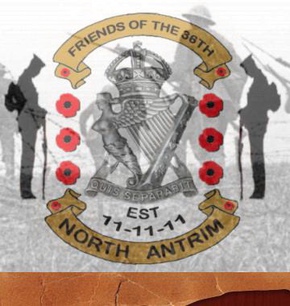
WALKER, Alexander
| Service Number: | 2938 |
|---|---|
| Enlisted: | Not yet discovered |
| Last Rank: | Private |
| Last Unit: | 48th Infantry Battalion |
| Born: | Antrim, Northern Ireland, 1885 |
| Home Town: | Greenbushes, Bridgetown-Greenbushes, Western Australia |
| Schooling: | Ballycregagh School, Northern Ireland |
| Occupation: | Miller |
| Died: | Killed in Action, Somme, Picardie, France, 6 August 1916 |
| Cemetery: |
No known grave - "Known Unto God" Villers-Bretonneux Memorial, Villers-Bretonneux, Picardie, France |
| Memorials: | Australian War Memorial Roll of Honour, Greenbushes War Memorial, W.A., Kings Park Western Australia State War Memorial, Villers-Bretonneux Memorial |
World War 1 Service
| 5 Oct 1915: | Involvement Private, 2938, 16th Infantry Battalion (WW1), Battle for Pozières , --- :embarkation_roll: roll_number: '12' embarkation_place: Fremantle embarkation_ship: HMAT Hororata embarkation_ship_number: A20 public_note: '' | |
|---|---|---|
| 5 Oct 1915: | Embarked Private, 2938, 16th Infantry Battalion (WW1), HMAT Hororata, Fremantle | |
| 6 Aug 1916: | Involvement Private, 2938, 48th Infantry Battalion, Battle for Pozières , --- :awm_ww1_roll_of_honour_import: awm_service_number: 2938 awm_unit: 48 Battalion awm_rank: Private awm_died_date: 1916-08-06 |
Alexander Walker History
Born Gladhill, Stranocum, son of David and Elizabeth Walker.
Lived in Bridgetown, WA. Enlisted Blackboy Hill, WA.
The Walker family lived at Gladhill, close to Stranocum, a village about four miles east of Ballymoney. The family worshipped at the nearby Bushvale Presbyterian Church and it is there that Alex is commemorated on the Roll of Honour. As children, they all attended the old Ballycraigagh school. Relatives of the family still live in the same area and Alex’s name is engraved on the Stranocum War Memorial.
As a young man Alex emigrated to Western Australia a few years before the start of the 1st World War (TW - in January 2013, with brother David) and was a timber worker there. On the outbreak of hostilities he decided to enlist and presented himself for a medical examination at Bridgetown on 20th July 1915 (recruiting for the Australian Expeditionary Force, later called the Australian Imperial Force, did not officially start until 12 August 2014 - TW) – he officially enlisted at Blackboy Hill on 29th September 2015. He was 5’ 7” tall with a fair complexion, grey eyes and light brown hair.
His troop shipment embarked from Fremantle on 1st October 1915 on the ship A30 “Honorata.”.
The troops were taken to Egypt. At Abbassia (Cairo) Alex was admitted to hospital where he remained for three weeks, being discharged on 20 November 1915. On 8 January he re-joined his unit at Ismailia (on the Suez Canal, 150km NE of Cairo) but on 25 January he was again taken to hospital, this time at Cairo with laryngitis. On recovery he was transferred to the 48th battalion on 3 March at Tel-el- Kabir (between Cairo and Ismailia – this massive camp hosted 30,000 men - at this time General Birdwood was combining Gallipolli veterans with new recruits in creating 6 Divisions of men to fight on the continent). Three weeks later, on 24 March, he was again admitted to hospital, this time with tonsillitis. Five days later he was discharged from hospital and on the 31st re-joined his unit at Serapeum 10km south of Cairo. On 2 June 1916 they embarked on H.M.T. “Caledonia” at Alexandria and reached Marseilles on 9 June. There followed a very long train journey up to the Western Front but they arrived in time for the Battle of the Somme.
Alex was killed in heavy fighting at the Battle of the Somme on 6 August 1916. He has no known grave and is commemorated on the Villers-Brettoneux War Memorial. Along with his military records there is a note listing personal possessions removed from his pockets at the time of his death. It follows that he must have been buried close to where he fell, a short time after being killed. Subsequent searches of the battlefield after the cessation of hostilities failed to find his body and he was declared missing. He will be there still.
His brother, John, also served throughout the war, but survived (this is incorrect - Grandad John ie ‘Jack’ did not actually serve, but his brother David did – see below. John married Ivy Hancock in Balingup 25 June 2016 only six weeks before Alexander was killed).
The Australians were at this time embroiled in desperate fighting close to the village of Pozieres and it is believed to have been here that Alex was killed. Pozieres village sits astride the main Albert-Bapaume road and at the start of the Battle of the Somme was in German hands. The higher ground where Pozieres windmill was situated was a very useful vantage point and it was this higher ground that the British Armies were so anxious to capture. Thousands of Australian soldiers were lost in the fierce fighting which took place in the battles for Pozieres village as the many cemeteries in the region testify. One only has to visit the region and study the layout of the trenches to realise something of the harsh realities of life in the front line. Most of these young men were away from home for the first time, many of them never to see home again, and it must have been a daunting task to come out of the comparative shelter of their trenches and attack an army that they knew was lying in wait for just such an opportunity. They eventually took Pozieres Ridge after huge loss of life. This is why we want the names of men like Alex Walker inscribed on the Ballymoney War Memorial. They have earned it.
Submitted 28 February 2019 by Murray Walker









